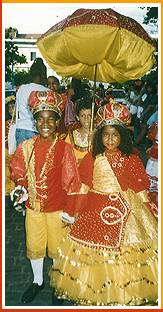

The king
and queen of a children's nation |
 |
THE
COURT PROCESSION IS CALLED MARACATU
With
the abolition of slavery in 1888, and the proclamation of the
Republic, in 1889, the King of the Congo - Muchino Riá
Congo - lost his reason to exist. And the courts of the black
kings, which were already present in the carnival, for their own part,
began to take on the leaders of the African
religions (known as babalorishas) as their temporal and spiritual leaders. They were to be
seen on
the streets of Recife not only on religious feast days of our Lady
of the Rosary, but also during the carnival festivities.
After the abolition of slavery however, the
old courts of the African Nations that continued to be present in
the Recife carnival under the leadership of their babalorishas, began
to be called Maracatus. It is worth noting that this name occurred particularly when the
news had any connotation with the police, such as reported in the Diário
de Pernambuco of 26th February 1889.
Even recently, according to
a
statement by the President of the Crowned Lion Nation, Luiz de França,
who died at 95, "Without mincing words, and calling a spade a
spade, I'd just say that
Maracatu is an African sect" (Diário de Pernambuco 14th January 1996).
|
The most touching description of
a carnival maracatu from the beginning of the century, comes from
Francisco Augusto Pereira da Costa (1851-1923) who, in 1908, describes the
court procession in Folk-Lore Pernambucano1:
A standard breaks out at the head of the procession, with archers on
either side, and following this, in two rows, are beautifully adorned women
with their turbans ornamented with multicolored strips of material,
sequins and many other decorations. Featuring in the middle of these two
rows, we are able to see numerous other characters, such as those who conduct
the religious charms - the wooden cockerel, a straw alligator and a doll
dressed in white with a blue cape. After this, moving in columns, we see the
dignitaries of the court who close the king and queen's royal procession.
These two characters displaying the royal insignias, such as the
crown and the scepter, and with long capes being held by train bearers, march under
an enormous protective parasol, guarded on either side by archers.
At the rear of the procession come the instruments: drums, horns and others of African
aspect, which accompany the marching songs and diverse dances with a
horrible din.
Aruenda qui tenda, tenda,
Aruenda qui tenda, tenda,
Aruenda
de totororó.
1
COSTA, F. A . Folk-Lore Pernambucano. Rio: Imprensa Oficial,
1908.

|